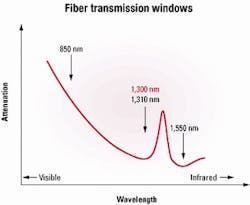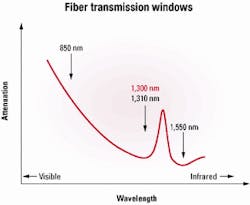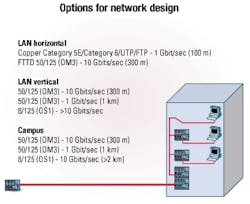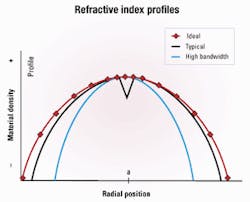Fiber and the enterprise network
Performance-rated fiber categories may ease the task of designing a cabling infrastructure that can weather the technology changes of a decade or more.
KEN WILLIAMS and JONATHAN BLITT, ITT Industries, Network Systems & Services
Information technology is critical to most businesses, yet the infrastructure cabling that supports network applications outlives active equipment by a factor of five. While PCs and switches are typically used for two or three years; cabling is expected to last a minimum of 10 years before it is upgraded to fit new technology and standards. A cabling solution must support current bandwidth requirements of 100 Mbits/sec to 1 Gbit/sec as well as future demands of 10 Gbits/sec up to 100 Gbits/sec.
To meet these demands, the fiber industry is following the lead of the copper sector and introducing performance-based categories: optical multimode 1 (OM1), OM2, OM3, and optical singlemode 1 (OS1). The three multimode categories relate to the core/cladding diameters of the fiber, 62.5/125 microns, 50/125 microns, and high-bandwidth 50/125 microns, respectively. These categories, set by the International Organization for Standardization (ISO) and the International Electrotechnical Commission (IEC), are paving the way for the future of network architecture.
Today's robust applications place greater demands on data-communications networks, requiring network designers to make careful choices when selecting fiber-not always an easy task. The hype generated by marketing and advertising campaigns can often create uncertainty about the limitations of different fiber types. Performance-related fiber categories offer an objective means by which to compare fibers.
All data networks have two very distinct zones of operation. The horizontal, or desktop, zone is the infrastructure extending from the desk to the first set of active electronics. The backbone, or vertical zone, consists of the cabling that aggregates the horizontal traffic and carries it to the data or switch room. These zones relate not only to distance, with the length of the runs increasing respectively, but also to the amount of traffic passing along the infrastructure and the required bandwidth. In a campus environment, a third zone is added to support greater distances. For each zone, network designers must address a different set of assumptions; costs rise as demand, distance, and bandwidth increase.The highest-rated copper on the market is capable of serving the needs of the desktop zone of the network, where transmission requirements rarely exceed 1 Gbit/sec. Decisions become more critical-and cost plays a greater role-in the backbone and campus zones, because cabling choices must be made with respect to the active electronics used to deliver the data. The area of the network that poses the greatest risk of becoming a bottleneck is the vertical backbone where the aggregation of hundreds or even thousands of data users can rapidly surpass the capabilities of copper cable. The backbone often requires the use of fiber.
Until recently, the options for network backbone design were somewhat limited. To achieve gigabit performance over any significant distance, companies were required to use either singlemode fiber or additional active equipment in conjunction with their existing OM1 or OM2 fiber-both solutions were expensive to implement. The high-cost active equipment used for transmission over singlemode fiber made the singlemode option only viable for very extended drive distances. The introduction of OM3 multimode cable, however, provides a relatively low-cost way to deliver multigigabit performance over vertical backbone drive distances.
Companies utilizing OM3 fiber in their backbone designs can achieve a scalable, high-bandwidth solution capable of delivering Gigabit Ethernet to distances beyond 1 km. These extended drive distances for 1-Gbit/sec allow more diverse cabling routes, which can improve network resilience and increase the scope of network design. Ultimately, organizations will have the ability to implement centralized network architectures, which will allow network designers to reduce and redistribute the active equipment and lower overall network costs.
Multimode-fiber solutions cost less than singlemode because the light sources used within the active equipment at either end of a fiber channel-the major expense-are low-cost devices reducing the overall cost. In singlemode systems, high-power lasers are used to drive the signal the many miles over which singlemode transmission lines usually extend. Multimode systems, on the other hand, use low-cost 850-nm laser light sources called vertical-cavity surface-emitting lasers (VCSELs).
Currently VCSELs are only commercially available for the 850-nm operating window. The OM3 fiber cable can use VCSELs to enable delivery of 10-Gigabit Ethernet traffic over drive distances up to 300 m and Gigabit Ethernet up to 1 km, providing the most cost-effective solution for vertical backbone and fiber-to-the-desk applications.
In LANs, the light sources used for legacy application protocols are typically LEDs. An LED is a low-cost de vice that is much less powerful than a laser but suitable to drive optical signals over the distances required by vertical backbone applications. At speeds of 1 Gbit/sec and above, LEDs simply cannot switch at high enough rates, therefore the faster operating 850-nm VCSELs are used within active equipment.There are three trans mission-operating windows for fiber-optic systems. Multi mode fiber supports the first and second operating windows at 850-nm and 1,300-nm wavelengths, while singlemode devices operate in the second and third windows, operating at 1,310 nm and 1,550 nm (see Figure 1). The most common and cost-effective transceiver devices for LANs use the 850-nm operating window.
Although there are alternative methods of achieving 10 Gbits/ sec, all have their limitations or are more expensive than using OM3 fiber solutions. With the introduction of OM3-compliant, high-bandwidth 50/125-micron fiber cable, companies will increase the flexibility of their network design and achieve data transfer rates up to 10 Gbits/sec at the lowest available cost.
The OM3-compliant fiber cable will enable delivery of 10-Gigabit Ethernet over one fiber link for up to 300 m, almost four times greater than OM2 fiber, which supports up to 86 m (see Figure 2).
Active equipment is the primary cost in a LAN fiber-optic transmission channel. The high cost of optical active equipment is in part due to the packing density of the components on the circuit boards. Therefore, the footprint of the interface between the circuit board and the cable-the connector-becomes critical in determining equipment costs.
Thus, equipment manufacturers are working to develop connectors that have a smaller footprint and take up less space on the circuit boards. As a result, the small-form-factor (SFF) connector was born. However, no single connector has found favor universally. The fiber industry tried to develop an optical version of the RJ-45, the universally accepted connector in the copper cabling world, but has not yet achieved that.
Each of the different connectivity options available today has its virtues. Ultimately, the connector choice depends on the clients' active equipment supplier rather than the technical merits of one connector versus another. Within any fiber network though, the most important issue is the choice of fiber type.
If OM3 fiber can operate using 850-nm VCSELs and offer organizations the associated cost benefits, then why are OM1 and OM2 fibers not capable of using the same method? The answer lies in understanding the basics of the fiber manufacturing process and the resultant fiber profile.
All OM category fibers involve a particular type of multimode fiber; this fiber is known as graded index multimode fiber. The production of graded index multimode fiber is more complicated than that of singlemode fiber. A generic method known as modified chemical vapor deposition (MCVD) is used by the few organizations globally that manufacture graded index multimode fibers. A series of manufacturing processes, which are very carefully monitored and controlled, ensure that the fibers are consistent in their physical dimensions and characteristics. What begins as about a 1.5-m glass preform ends up as a continual length of fiber, typically 10-20 km.
MCVD is combined with a unique refractive index profile to produce high-bandwidth OM3 fiber. Figure 3 shows three different refractive index profiles. When a fiber is manufactured, it consists of two distinct regions: the core and cladding. These two regions have different refractive indices, and it is this characteristic that causes light to be internally reflected along the length of the fiber where these two materials meet. Multimode fiber, as the name suggests, allows many rays of light at the same time into the fiber core. That's in contrast to singlemode fiber, where just one ray of light is transmitted. To ensure that the decoding of a transmitted signal happens correctly, it is important that the multiple rays of light transmitted in a multimode system arrive at the far end of the fiber at the same time. When this does not happen, a phenomenon known as differential mode delay (DMD) occurs. The process of manufacturing graded index fiber is designed to create a profile that minimizes DMD-the lower the delay, the higher the potential bandwidth throughput of the fiber.The red line in Figure 3 shows an ideal profile for a multimode fiber. The center of the profile corresponds to the center of the multimode-fiber core. At this point, the material's density is greatest; therefore the modes of light traveling along this part of the core are slower than any of the other modes moving through the outer regions of the core material.
In the real world, an ideal profile is seldom achieved, however. The black line shows the more typical profile of OM1 or OM2 fiber. This profile indicates a distortion, which usually occurs around the central region of the core profile and reduces the available bandwidth. The distortion is due to abnormalities that occur during the manufacturing process. It is primarily the result of less defined control methods adopted during manufacture and the lower overall efficiency and effectiveness of the MCVD process itself.
The third profile, the blue line, is OM3 high-bandwidth fiber. The shape of the profile differs significantly from that of high-capacity fiber. The accuracy of the process to achieve such a profile is much greater than the process required to produce a high-capacity OM2 fiber. The importance of this distinction cannot be understated. The OM3 manufacturing process is so highly controlled that, unlike the typical profile of the OM1 and OM2 fibers, the OM3 profile demonstrates almost no perceptible difference when compared to the ideal profile in the important central region of the core of the fiber. That gives OM3 fiber an operational bandwidth above 2 GHz and allows it to transport higher data speeds over longer distances.
This last point is significant because to run Gigabit Ethernet and 10-Gigabit Ethernet over OM3 cable, laser light sources-VCSELs-need to be used. These lasers transmit light primarily within the central part of a multimode fiber's core, which would include the distortions found in OM1 and OM2 fiber types.
Installing fiber for future use cabling infrastructure, often perceived as low-end technology, must be able to support an organization's network for 10 to 15 years, primarily because of its high installation cost and the amount of time and disruption required to install a system.
Thus, it makes sense to design-in as much futureproof technology as is cost-effective. One option in the vertical backbone is to install dark singlemode-fiber cable. Typically, 60% to 70% of an installation's cost is in the labor element. Therefore, the additional cost of installing OS1 dark singlemode (unterminated fiber) at the same time as OM3 is proportionally reduced. The organization then has the opportunity to terminate and connect the singlemode fiber as application speeds or bandwidth dictate.
Within the horizontal portions of the LAN, copper cabling is the standard choice of most companies. Copper cabling is a relatively cost-effective means of providing access to voice and data services for a large number of people. When the network architecture is designed correctly, copper cabling can provide the flexibility to meet most office reorganizations. It is also capable of reliably supporting data rates of up to 1 Gbit/sec, which is sufficient for the vast majority of today's users.
With a 10-15-year lifespan in mind, however, companies must consider data rates to the desktop in the future. For rates greater than 1 Gbit/sec to the desk, extended transmission distances from the equipment room (over 100 m), or increased data security, copper is no longer an option. An OM3 fiber-to-the-desk solution is the correct choice. This solution would increase the opportunity to centralize the network, offering savings in real estate, active equipment, and maintenance support.
Upgrading to fiber-to-the-desk takes some doing-the active equipment on the network must be replaced with optical technology or media converters are required. Companies must weigh these costs when analyzing fiber upgrades. If fiber is the preferred solution, then it makes sense to include an option for fiber that is capable of supporting 10 Gbits/sec to the desk to prevent another infrastructure upgrade at some point in the future.
In summary, the cost-effective implementation of serial transmission of 10-Gigabit Ethernet over multimode fiber will only be possible with the use of laser light sources within transceiver devices and high-bandwidth fiber.
The IEEE draft specification for the 10-Gigabit Ethernet protocol has stated that the fiber of choice to enable high data rates at the proposed drive distance of 300 m is OM3 50/125-micron fiber. Serial transmission at the 850-nm wavelength offers the lowest-cost solution for 10-Gbit/sec speeds because the majority of the transceivers on the market operate at 850-nm and the active equipment at either end of any transmission link is the predominant driver of cost.
Even as transmission methods change over time, OM3 high-bandwidth fiber will provide greater drive distances compared to other fiber options. Given that the major cost of any transmission link is the active equipment that connects to the cabling medium, it makes commercial sense to defer upgrades in active equipment for as long as possible.
Ken Williams is senior product manager, fiber optics, and Jonathan Blitt is president of the Americas for ITT Industries, Network Systems & Services (Basingstoke, England).



